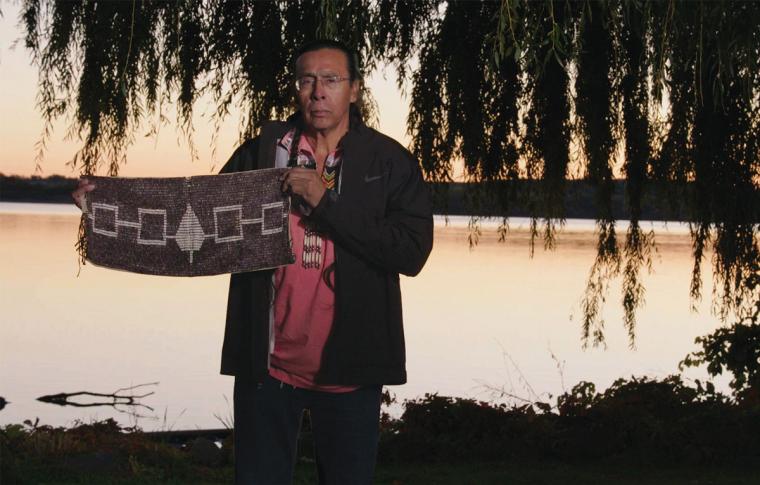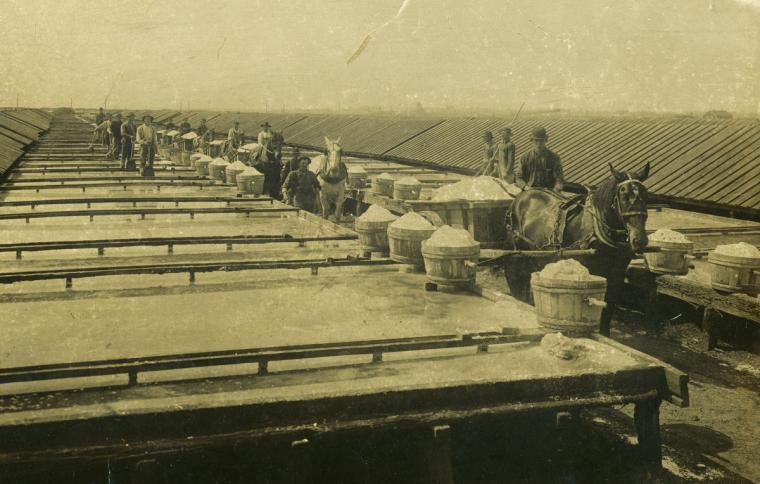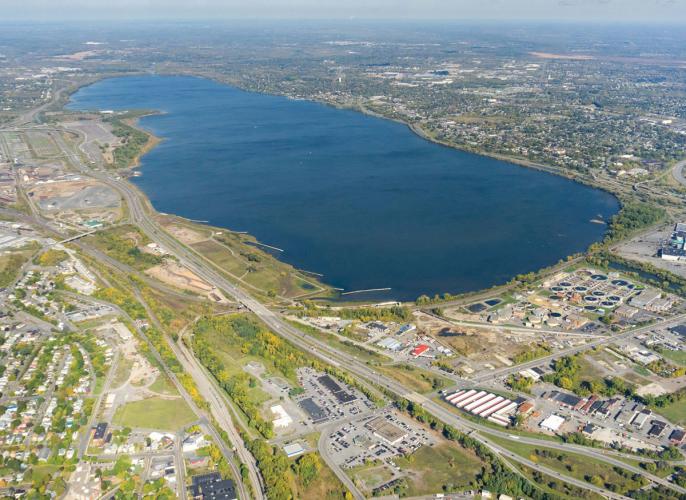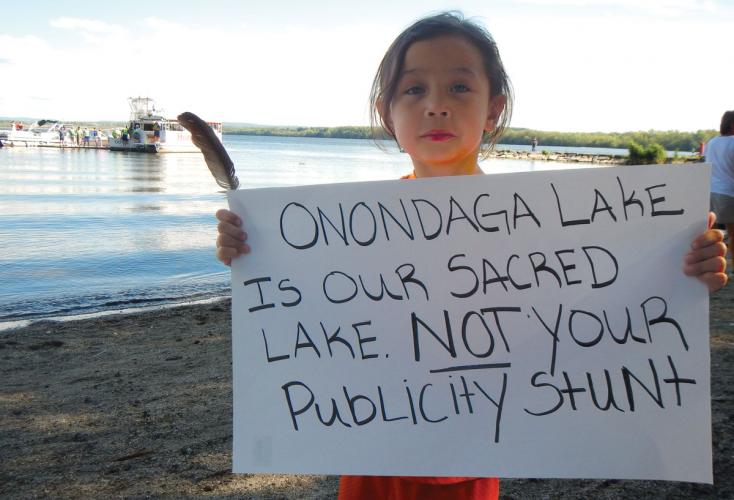On a sultry summer day more than a decade ago, Betty Lyons and her young son, Garrett, were driving past Onondaga Lake when the 7-year-old noticed an acrid smell. Betty explained to Garrett that the odor was from pollution in the lake. When the boy asked his mother why people didn’t clean it up, she explained that no one wanted to spend the money. He then inquired, “Did they ask the fish?”
In that innocent question—who will take care of this lake—a millennia of culture and hundreds of years of history were embodied. Garrett and Betty Lyons are members of the Snipe Clan of the Onondaga Nation, which now lies about 8 miles south of the 3,000-acre lake on the outskirts of Syracuse in Central New York. Their people’s territory once stretched to the lake and beyond.
But by the late 20th century, 300 years after Europeans colonized the area, Onondaga Lake carried the stigma of being the country’s most polluted body of water. This has been an open wound for the Onondaga people, who maintain their sacred connection to the lake. Even Garrett’s Onondaga name, Ohneganoh, means “cool water.”
“The lake is weeping,” says Betty, who is also executive director of the American Indian Law Alliance, an organization that has helped the Onondaga fight for rights to take care of the lake. “And we do, when we go and bring our children. I always cry when I go there.”
The Foundation of Peace
Though generations of the region’s Indigenous people once relied on Onondaga Lake for its abundant fish, this body of water has been far more than a source of sustenance. It was the setting for the establishment of the principles of the people of the Haudenosaunee Confederacy (which French colonists called the Iroquois). The Haudenosaunee say that about a thousand years ago, their prophet known as the Peacemaker brought the first five nations of the confederacy—the Mohawk, Oneida, Onondaga, Cayuga and Seneca (the Tuscarora joined the confederacy in 1722)—together in peace. On the shores of the lake, the Peacemaker set forth what would become the principles that their people would live by, including nonviolence, fundamental elements of democracy, stewardship of the natural resources that support all life and preservation of nature for future generations.
The confederacy is represented by a longhouse, and as the Onondaga Nation is traditionally the central meeting place for the nations, the Onondaga people are known as the Keepers of the Council Fire. The Onondaga today take the stewardship and preservation of nature no less seriously than they did when these charges were first brought to them. “We were taught how to give thanks to all the things that the Creator had put down for us,” says Sid Hill, who wears the ages-old mantle of Tadadaho, or leader of the Haudenosaunee Confederacy.
“It’s a reciprocal relationship that we have with all the living things around the lake and the water,” adds Lyons. “It’s not a commodity.”
Yet European colonists thought differently. French missionaries began commoditizing Onondaga Lake almost immediately after they arrived in the 17th century and noticed it had rich deposits of salt. Word spread and during the next two centuries, the business boomed and the commodity was shipped across the country. Hundreds of acres around the lake would be converted to salt evaporation beds and boilers.
In 1882, William B. Cogsworth staked out much of the eastern shore for his Solvay Process Company, named for a method of making soda ash, which is used in making common products from glass to baking soda. “There are three main ingredients you need for the Solvay process: limestone, salt and water,” says Robert Searing, staff historian at Onondaga County’s Historical Association. For that, he says, “You can’t find a much better place anywhere in America.”
Searing calls the soda ash industry an “engine that connected Syracuse to American expansionism in the Industrial Age like no other.” Its process was also stunningly inefficient, producing about 50 percent more waste material than product. The most convenient place to dump the waste was right in front of the plant, along the lakeshore. Thus began a pollution legacy that would continue for more than a century.
A Compounded Problem
By the close of the 19th century, defilement of the lake had already captured public attention, though many locals regarded it as more modern marvel than public nuisance. An 1897 newspaper account describes mounting layers of lime waste along the lake’s southwestern shore as “cliffs of pure white,” and declares that the already prodigious challenge of waste disposal from the Solvay Process Company had been “solved” by dumping it along the lake.
“Terrace above terrace the lime is being built up, hundreds of tons a day being carried into the lowlands along the lakeshore,” reported the Standard, a Syracuse newspaper. “Plenty of Room for It,” a subheadline blithely declares. The article goes on to explain that leachate from the waste piles “whitens the bottom of the lake somewhat” but “does no damage.”
Around this time, newspapers reported that the ironically named president of Solvay Process, Frederick Rowland Hazard, estimated that his operation was sucking 15 million gallons of water per day from the 4.6-square-mile lake while spreading 500 to 600 tons of waste material per day along its shores. Within a few years, the volume was reported as 2,000 tons per day.
On the opposite corner of the lake, a different kind of metamorphosis had unfolded. Victorian-era pleasure seekers flocked to ornate leisure palaces such as The Iron Pier and The White City, “fleeing to the loveliest haunts of nature for a little respite from the busy cares of life,” as an 1870 promotional booklet described it. “Hundreds of row boats, scores of sail boats, and half a dozen or more tidy little steamers give life to the lake and its surroundings during the summer months.” Yet always visible across “this bright little body of water which lies at our very doors” were the ever-present columns of black smoke, billowing from industrial stacks on the southwestern shore.
“You had so many industrial concerns in Syracuse that were pumping into the watershed,” recalls Searing. “Solvay Process was just one of many; it just happened to be the biggest.”
Syracuse got a sense of just how big on Thanksgiving Day of 1943, when residents near the plant woke up to a wall of caustic “white lava” that burst through waste bed Dike #7 and quickly inundated local roads, part of the state fairgrounds, and a cluster of homes in the nearby Lakeland district. The mess took two years to clean up. Some residential areas were rezoned to preclude new waste beds but little else came of it. Local officials deferred “beautification” of the lakeshore as part of their post-war agenda.
Alongside the soda ash plant, steel mills and other heavy industry completed this “wonderful metamorphosis on the face of nature,” as a 1903 newspaper account described it. Over the years, as heavy industry multiplied around the lake, a toxic “smorgasbord” of chemicals was added to the mix: heavy metals such as mercury and cadmium; volatile compounds, including benzene, toluene and acetone; polychlorinated biphenyls (PCBs) and dioxin. Storm outflows from the city’s wastewater treatment plant, positioned at the lake’s inlet, added ammonia, phosphorus and bacteria that starved the lake of oxygen and caused carpets of toxic blue-green algae to bloom every summer.
Onondaga Creek, which connects the Onondaga Nation with the lake, still carries storm runoff and heavy metals from defunct salt wells into the lake. However, after hundreds of millions of dollars were spent on upgrades to the municipal sewage infrastructure and plant, this is at much lower levels than in years past.
“It’s a severely hurt system,” says biologist Neil Patterson (Tuscarora), assistant director of the Center for Native Peoples and the Environment at the State University of New York. “It has been through a lot of physical and spiritual trauma.” Patterson cites a long history of draining wetlands around the lake, clearing timber to fire salt boilers, followed by 140 years of heavy industry on the lakeshore.
“There’s not one square inch of the shoreline that has not been disturbed,” laments Jeanne Shenandoah, clerk of the Onondaga Nation. “But we still hold it sacred.” Indeed, Betty Lyons says the Onondaga people still hold regular water ceremonies at the lake, in which Indigenous peoples from far and wide bring clean water from their own lands and make offerings of it “to help purify and clean” the lake.
Slow Progress
In 1994, the U.S. Environmental Protection Agency declared the lake a national priority Superfund site, a designation reserved for the most egregious cases. In fact, so ubiquitous was the pollution that the EPA divided the area into 12 Superfund “sub-sites,” including several upland sources of pollution in the watershed, each with its own challenges.
But progress on the cleanup was torpid and in 2005, the leaders of the Onondaga Nation concluded that the only way to save the lake would be to regain control of it. They filed a land rights lawsuit against the State of New York as well as the City of Syracuse, Onondaga County and industries along the lakefront, principally Honeywell International (formerly Allied Chemical and Allied-Signal, the descendant companies of Solvay Process). The suit sought the return of lands that have been home to the Onondaga people “since the dawn of time” and stated that those lands, including the lake, were unlawfully wrested from them by the State of New York in a series of fraudulent treaties between 1788 and 1822. The Onondaga Nation asserts that the pacts were never legally ratified by either side, nor were the rightful leaders of the Onondaga Nation even represented at the signing. State of New York officials also disregarded significant treaties between the United States and the Six Nations that had guaranteed the confederation sovereignty and recognized its lands. Today, the Onondaga Nation sits on only 7,300 acres, a small fraction of its former territory that once covered more than 2 million acres.
The Onondaga people say their aim was never to oust anyone already living on their original lands from their property but rather to give the nation some leverage in negotiations to restore the lake. “The idea was to protect the land for our future generations,” says Freida Jacques, clan mother for the Onondaga’s Turtle Clan, “for all the people who live in this area.” It’s an attitude that dates far back in her culture, all the way to the Great Law of the Peace and its imperatives for sustainability. “I’m grateful that we still have our ways,” says Jacques, “enough to understand what our responsibilities are.”
The land rights suit died quickly in federal district court. However, in 2007 a deal was struck with regulators and Honeywell providing that the company would undertake a $450 million cleanup program, which included dredging more than 2 million cubic yards of lake bottom and “capping” 475 acres to stabilize contaminants in the lake bed. Reports soon emerged that the sand cap had “slipped” on several occasions. Tadadaho Hill called it “a Band-Aid.”
“They spent a half-billion dollars or so and they crow about how much that is,” says Joseph Heath, general counsel for the Onondaga Nation. “The problem is that in order to clean up that mess fully, it would’ve taken $2.8 billion.” That would require dredging most of the lake bottom and other costly measures that do not appear to be on the horizon. Officials at New York’s Department of Environmental Conservation (DEC), which oversees the cleanup, say the slippage was limited to relatively few acres, that those portions were redesigned and repaired, and that currently the cap is “performing as it was designed and constructed.” Currently, Honeywell is using a nitrate application to isolate mercury on the lake bed from most living organisms and operates a groundwater treatment plant to reduce toxic chemicals from reaching the lake through the water table.
At this point, regulators consider the cleanup to be mostly complete. “We may not be necessarily at the end of our journey but we’re definitely pretty far down the road,” says DEC project manager Tim Larson, “And I would say it’s very encouraging, the state of the lake at this point in time.” Larson says industrial chemicals are now “at manageable levels” and contaminants from urban runoff are “within limits.” The remaining task is mostly monitoring to ensure that remedial strategies keep working, a process that he says will “be ongoing for a very, very long period of time.”
“We have containment here,” he adds. “We don’t have an issue where we have kind of a continual bleeding of contaminants out into the environment.”
More than 60 species of fish appear to be thriving in the lake, compared to fewer than nine in the 1970s. In response, bald eagles roost in the cottonwoods at the south end of the lake, a magnet for local birders and photographers.
“We didn’t send out a memo and ask the eagles to come,” says Matthew Marko, the DEC’s Region 7 director. “They came because the environment is welcoming to them.”
Yet the leaders of the Onondaga Nation are not convinced. “Yes, it’s nice to see eagles at the lake,” says Tadadaho Sid Hill. “But what kind of fish are they eating? You can’t eat those fish.”
After a 45-year blanket ban on fishing, limited sport fishing is now allowed at the lake, though a sign at the public boat launch warns that, “Fish from these waters contain chemicals and should not be eaten by women or children.” The sign cautions that “others should limit what they eat,” though it doesn’t say by how much. Getting any sort of warning signs at the lake is something the Onondaga Nation counts as one of its rare victories in the decades-long lake struggle.
Recently local officials have proposed a public beach at the lake, though a 2019 survey by Onondaga County indicated that only two in 10 residents would feel safe swimming there. As of March 2021, the EPA had not removed Onondaga Lake from its list of priority Superfund sites.
The Haudenosaunee continue to remind the state of New York and the U.S. government of their agreement to honor the sovereignty of the confederacy and recognize its lands, including access to Onondaga Lake. Each November, leaders of the confederation carry the wampum belts that represent these treaties to Canandaigua, about 70 miles west of Syracuse, and parade through the city where the 1794 treaty was signed. In 2016, Haudenosaunee leaders brought a replica of the George Washington Belt representing the 1794 Canandaigua Treaty to a meeting with White House officials as a reminder of the two governments’ promises. “We have to educate our neighbors,” says Betty Lyons.
Meanwhile the Haudenosaunee’s duty to preserve Onondaga Lake for future generations weighs heavily on Lyons and the other Keepers of the Council Fire. “We wake up every day fighting,” she says. Today this fight is mostly on the public education front, including loudly advocating for restoration of their lake and aspirations to update the K-12 curricula in local schools to include Haudenosaunee history.
“I feel a great sadness because the water is such a precious thing to us,” says Shenandoah. “That lake has such great spiritual significance to us. We listen to it in our teachings that helped to keep us as a people strong and spiritual and believing in our ways.” She says the Onondaga Lake struggle is “keeping our ways alive.”
“I don’t think it’s gonna end next year,” says Lyons. “I think this is a fight my kids will have to pick up.”
“When I look back at our ancestors, to what they have gone through,” Hill says he realizes “you know, we’re still here. We have what we call ‘oñgwagoñhsohda’.’ That means we’re survivors.”






